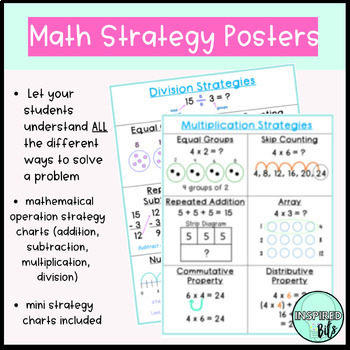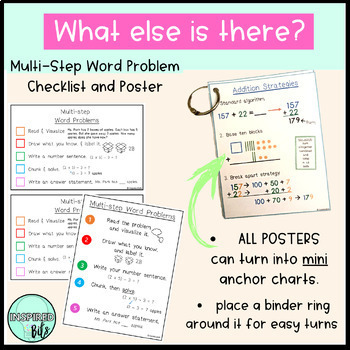Mini-Anchor Math Strategy Charts and Checklists | Add Subtract Multiply Divide
- PDF
What educators are saying
Also included in
- Includes my best selling math strategy charts for addition, subtraction, multiplication, and division. ALL Strategy Charts Includes a Visual with different strategies. You can also choose the option to print it to minimal size for kids to easily hold onto it/to take it home. This is a growing bundlePrice $23.00Original Price $26.00Save $3.00
Description
Math Strategy charts using all mathematical operations (addition, subtraction, multiplication, and division) for third grade or fourth grade. The math strategy charts can be used as posters/mini anchor charts for our visual learners, and provides guidance in choosing the strategy that works BEST for them. Also included are math self-checklists which are differentiated (high, on-level, and below). It used to self-assess when completing their work, and when solving mathematical word problems to DOUBLE-CHECK their work.
DETAILS of What's Included:
1. Three differentiated self-checklists for solving one-step word problems
- 3 differentiated checklists (high, low, and on-level) - includes images and labels for our visual learners
- each checklist comes in four different checkbox colors
- focuses on the C.U.B strategy
- already made mini-checklists
2. ONE multi-step word problem checklist
- best for students who are ready to work on two-step or more word problems
- formatted as number steps or as checkboxes (please look at the preview)
2. ALL Strategy Charts Includes a Visual with different strategies. You can also choose the option to print it to minimal size for kids to easily hold onto it/to take it home.
1. Addition Chart (3 strategies)
2. Subtraction Chart (3 strategies)
3. Multiplication Chart (6 strategies)
4. Division Chart (6 strategies)
Lastly, since I've created this - whenever I ask my students "What other strategy can you use besides..." or "What multiplication strategy are you using?" They are able to answer it in a heartbeat because the posters lay out the strategies for them. All they have to do is take a look!
- Follow me on instagram inspiredbits
- Contact me at inspiredbitss@gmail.com






